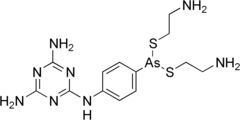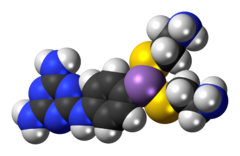This is an old revision of this page, as edited by Ozzie10aaaa (talk | contribs) at 14:54, 21 February 2023 (Cleaned up using AutoEd). The present address (URL) is a permanent link to this revision, which may differ significantly from the current revision.
Revision as of 14:54, 21 February 2023 by Ozzie10aaaa (talk | contribs) (Cleaned up using AutoEd)(diff) ← Previous revision | Latest revision (diff) | Newer revision → (diff) Chemical compound Pharmaceutical compound | |
 | |
| Clinical data | |
|---|---|
| Trade names | Immiticide, Diroban |
| AHFS/Drugs.com | International Drug Names |
| ATC code |
|
| Identifiers | |
IUPAC name
| |
| CAS Number | |
| PubChem CID | |
| ChemSpider | |
| UNII | |
| KEGG | |
| CompTox Dashboard (EPA) | |
| Chemical and physical data | |
| Formula | C13H21AsN8S2 |
| Molar mass | 428.41 g·mol |
| 3D model (JSmol) | |
SMILES
| |
InChI
| |
| (verify) | |
Melarsomine (melaminylthioarsenate) is an arsenic-based anthelmintic. In the U.S., it is marketed under the trade names Immiticide (Merial) and Diroban (Zoetis), and is approved by the FDA's Center for Veterinary Medicine for the treatment of adult heartworm (Dirofilaria immitis) infection in dogs. It is not approved for treatment in cats, or dogs in late-stage infection.
References
- Tilley LP (2008). Manual of Canine and Feline Cardiology. Elsevier Health Sciences. pp. 194–197. ISBN 978-1-4160-2398-2.
- Bonagura JD, Twedt DC (2013). Kirk's Current Veterinary Therapy XV. Elsevier Health Sciences. p. 2502. ISBN 978-0-323-22762-9.
External links
This antiinfective drug article is a stub. You can help Misplaced Pages by expanding it. |